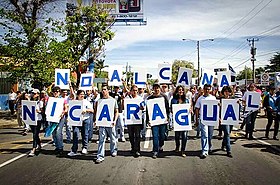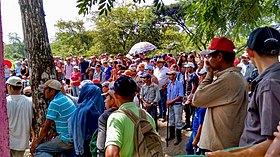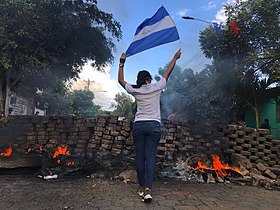| Protests against Daniel Ortega | |||
|---|---|---|---|
Top to bottom:
| |||
| Date | 24 December 2014 – present (9 years, 8 months, 3 weeks and 2 days) | ||
| Location | |||
| Caused by | Democratic deficit, political repression, social security, environmental protection, Nicaragua Canal proposal | ||
| Goals |
| ||
| Resulted in |
| ||
| Parties | |||
| Lead figures | |||
Campesinos
Students
Private sector
Government of Nicaragua | |||
| Number | |||
| |||
| Casualties | |||
| Death(s) | 2 (2014)[2] · 325–568 (2018)[3] | ||
| Injuries | 20+[4] (2014) · 433 (2018)[5] | ||
| Arrested | 47[4] (2014) · 200+ (2018)[6] | ||
The protests against Daniel Ortega were a series of protests against President of Nicaragua Daniel Ortega and actions performed by his government, the dismantling of the opposition, and violence against peaceful protesters. The protests began in 2014, when the construction of the Nicaragua Canal was about to begin, and several hundred protesters blocked roads and clashed with police during the groundbreaking of the canal.[7] Tens of thousands of Nicaraguans began to protest against President Ortega for what they believe to be a corrupt electoral system.[8][9]
The protests were renewed in April 2018 following the Ortega administration's decree of the Nicaraguan Social Security Institute's social security reform increasing taxes and decreasing benefits. Police and the paramilitary groups attacked and killed unarmed protesters, which made people to stand-up. After five days of deadly unrest, Ortega announced the cancellation of the reforms. Since then, Ortega faced the largest protests in his government's history, with the protest movement spreading to denounce Ortega in general and demanding his resignation.[10] Related protests continued in 2018 and thereafter.
- ^ Salinas, Carlos (29 April 2018). "Nicaragua se vuelca en una gigantesca marcha contra Ortega". El País (in Spanish). Retrieved 29 April 2018.
Convened by the Catholic Church, hundreds of thousands of Nicaraguans take to the streets of the country demanding peace and the end of the regime. The bishops warn Ortega that there can be no dialogue without guarantees.
- ^ Plumer, Brad (26 February 2015). "The fiasco that is the Nicaragua Canal, explained". Vox. Retrieved 15 July 2015.
- ^ "ONG establece en 568 el número de muertos en crisis de Nicaragua". La Vanguardia. 3 April 2019. Archived from the original on 15 October 2019. Retrieved 15 October 2019.
- ^ a b Rogers, Tim (27 December 2014). "Sandinistas 'bare claws' to defend Chinese canal in Nicaragua". Fusion. Retrieved 15 July 2015.
- ^ Oswaldo Rivas (23 April 2018). "Protesters demand resignation of Nicaraguan president after unrest". Reuters.
- ^ "Protestas en Nicaragua: los estudiantes que fueron liberados relataron la brutal tortura que sufrieron en prisión". Infobae (in Spanish). 24 April 2018. Retrieved 25 April 2018.
- ^ Lee Anderson, Jon (2 January 2015). "Breaking Ground on the Nicaragua Canal". The New Yorker. Retrieved 15 July 2015.
- ^ Wand, Alexander (14 June 2015). "Mass protests in Nicaragua as farmers claim planned canal will 'sell country to the Chinese'". The Independent. Archived from the original on 1 May 2022. Retrieved 15 July 2015.
- ^ "Clashes erupt at Nicaragua electoral reform protests". Euronews. 9 July 2015. Retrieved 15 July 2015.
- ^ "Thousands protest against Nicaragua government, urge calm". ABC News. Archived from the original on 24 April 2018. Retrieved 24 April 2018.


